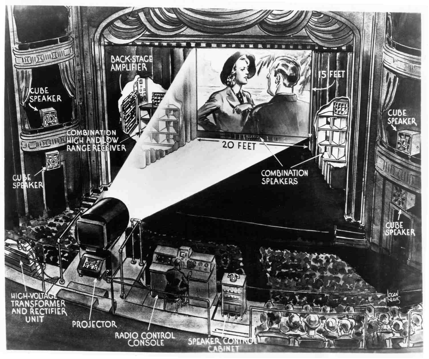There’s The Rub
This all sounds fine and most industry people seem to agree (at least in principle) on the basic technical ingredients and architecture of the system. The problem is that there are a lot of choices that have to be made if we are to establish a standard. No matter how carefully designed the standard is, these choices will by their very nature impose certain limitations on the capabilities of the system. Getting all of the creative and technical people in the business to agree on one set of standards is no mean task. The even bigger task, of course, is getting the people who control the purse strings at the theaters, the distributors and the movie studios to agree on a business model.
Triangle of Business Interests
There is a triangle of business interests involved in digital cinema formed by the studios, the distributors and the exhibitors. (The audience is left to view the new digital technology with awe and open wallets.) These major players that must agree on the business model for a digital cinema system to survive and grow. Among other things, this model will determine how money is distributed to pay for the capital equipment needed at the theaters (over 37,000 in US alone at least count), how fees are charged to pay for the distribution of digital masters and how revenues generated by the system are shared among the players. There are at least three major requirements that a successful business model must meet:
- No one gets hurt.
- Everyone keeps their job.
- Everyone makes more profits, except for the other two guys in the triangle.
At this time, it seems clear that the major obstacles to the adoption and implementation of a digital cinema system are mainly political and economic and not technical.
Major Promoters of a Business Model
Today, this author is aware of three major companies that are actively promoting business models for digital cinema. It’s probably best for each of these firms to speak for themselves, but let’s say that each one was a unique, although essentially similar, take on the correct technical implementation and divergent ideas on the business model. Each of these companies made presentations of one sort or another at the recent ShoWest2000 Convention in Las Vegas.
AndAction Corporation promotes it’s “Secure Media Network” concept and states on its web site that, “Through its Secure Media Network (SMN), AndAction applications and services enable secure distribution and management of a limitless variety of big screen digital entertainment. AndAction’s Digital Entertainment Infrastructure spawns new revenue generating opportunities including digital cinema, multiplayer video games, pay per view events, corporate presentations, distance learning and e-commerce.”
Real Image Digital’s focus is “on developing, integrating and maintaining the digital distribution network using the flexibility of electronic distribution technology. Real Image’s vision is that it is a ‘behind the scenes’ service provider managing the back and forth link and information flow between distributors of content and exhibitors.” Technicolor made a major investment in Real Image Digital last year.
Qualcomm has a group developing an end-to-end solution. Their site states that Qualcomm is, “combining its expertise in advanced image compression, electronic security, network management, integrated circuit design and high speed digital communications to provide a completely electronic delivery system for distribution of motion pictures to cinema theatres around the world.”
All of these companies are offering a complete technical solution as well as a business model.
